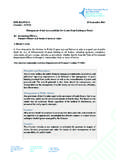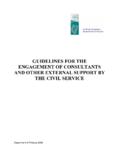Transcription of PARLIAMENT, THE COUNCIL, THE EUROPEAN ECONOMIC …
1 EUROPEAN . COMMISSION. Strasbourg, COM(2018) 29 final COMMUNICATION FROM THE COMMISSION TO THE EUROPEAN . PARLIAMENT, THE COUNCIL, THE EUROPEAN ECONOMIC AND SOCIAL. COMMITTEE AND THE COMMITTEE OF THE REGIONS. on a monitoring framework for the circular economy {SWD(2018) 17 final}. EN EN. 1. Introduction The transition to a circular economy is a tremendous opportunity to transform our economy and make it more sustainable, contribute to climate goals and the preservation of the world's resources, create local jobs and generate competitive advantages for Europe in a world that is undergoing profound changes. The importance of the circular economy to EUROPEAN industry was recently highlighted in the renewed EU industrial policy strategy1. The transition to a circular economy will also help to meet the objectives of the 2030 Agenda for Sustainable Development2.
2 In the circular economy action plan3, a circular economy is explained as an economy where the value of products, materials and resources is maintained in the economy for as long as possible, and the generation of waste minimised'. In the transition to a more circular economy , monitoring the key trends and patterns is key to understand how the various elements of the circular economy are developing over time, to help identify success factors in Member States and to assess whether sufficient action has been taken. The results of monitoring should form the basis for setting new priorities towards the long-term objective of a circular economy . They are not just relevant to policy makers, but should inspire all and drive new actions. This is why the Commission, in the circular economy action plan, committed to come forward with a simple and effective monitoring framework.
3 This has been echoed by the Council of the EU, in its conclusions on the circular economy action plan4, where it stressed the need for a monitoring framework to strengthen and assess the progress towards circular economy , while minimising the administrative burden'. Also, the EUROPEAN Parliament has called upon the Commission to develop indicators on resource efficiency to track progress towards the circular This Communication implements this commitment by putting forward a monitoring framework composed of a set of key, meaningful indicators which capture the main elements of the circular economy . The circular economy monitoring framework draws upon and complements the existing Resource Efficiency Scoreboard6 and Raw Materials Scoreboard7, which were developed in recent years by the Commission. The framework is presented on a website8 where all the indicators are available and will be kept up to date.
4 1. COM(2017) 479. 2. approach-sustainable-development_en 3. COM(2015) 614. 4. 5. EUROPEAN Parliament Resolution of 9 July 2015 on resource efficiency: moving towards a circular economy (2014/2208(INI)). 6. 7. 8. 1. 2. Monitoring progress towards a circular economy Monitoring progress towards a circular economy is a challenging task. The transition towards a circular economy is not limited to certain materials or sectors. It is a systemic change that affects the entire economy and involves all products and services. Ideally, indicators should primarily capture trends in preserving the ECONOMIC value of products, materials and resources as well as trends in waste generation. Just as there is no one universally recognised indicator of circularity', robust off-the-shelf indicators to describe the most relevant trends are in short supply.
5 With a single measure, or score, it would not be possible to appropriately capture the complexity and the many dimensions of the transition to a circular economy . For this reason, a set of relevant indicators will be used for this monitoring framework. One way of looking at the circular economy is to see how materials enter, flow within and (eventually) leave the economy . Such a visual overview can be provided by a material flows diagram, which shows all raw materials aggregated as well as grouped by categories of materials throughout the economy , from their extraction until they become waste. Figure 1: Material flows in the economy (EU-28, 2014)9, 10. 9. Source: Andreas Mayer, Willi Haas, Dominik Wiedenhofer, Fridolin Krausmann, Philip Nuss, Gian Andrea Blengini (forthcoming): Monitoring the circular economy in the EU28 - A mass-balanced assessment of economy wide material flows, waste and emissions from official statistics.
6 In: Journal of Industrial Ecology 2. Figure 1 presents an overview of material flows in the EU in 2014. The input-side on the left shows that 8 billion tonnes of materials are processed into energy or products annually in the EU. Only billion tonnes originate from recycling. On the output-side, it shows that out of the billion tonnes of waste that are generated only billion tonnes re-enter the system as recycled materials. The rest of the materials, equivalent to billion tonnes, is waste. These aspects point to a significant potential for improvement in particular by increasing the share of materials recycled as secondary raw materials and decreasing the production of waste. The monitoring framework aims at measuring progress towards a circular economy in a way that encompasses its various dimensions at all stages of the lifecycle of resources, products and services.
7 This is why the monitoring framework has a set of ten indicators (see Table 1). grouped into four stages and aspects of the circular economy : (1) production and consumption, (2) waste management, (3) secondary raw materials and (4) competitiveness and innovation. This broadly follows the logic and structure of the circular economy action plan. 10. Energetic use covers raw materials used for combustion or production of food and feed. 3. No Name Relevance EU levers (examples). Production and consumption 1 EU self-sufficiency for The circular economy should help to Raw Materials Initiative; Resource raw materials address the supply risks for raw Efficiency Roadmap materials, in particular critical raw materials. 2 Green public Public procurement accounts for a Public Procurement Strategy; EU. procurement* large share of consumption and can support schemes and voluntary criteria drive the circular economy .
8 For green public procurement 3a-c Waste generation In a circular economy waste Waste Framework Directive; directives generation is minimised. on specific waste streams; Strategy for Plastics 4 Food waste* Discarding food has negative General Food Law Regulation; Waste environmental, climate and ECONOMIC Framework Directive; various initiatives impacts. ( Platform on Food Losses and Food Waste). Waste management 5a-b Overall recycling rates Increasing recycling is part of the Waste Framework Directive transition to a circular economy . 6a-f Recycling rates for This reflects the progress in recycling Waste Framework Directive; Landfill specific waste key waste streams. Directive; directives on specific waste streams streams Secondary raw materials 7a-b Contribution of In a circular economy , secondary raw Waste Framework Directive; Eco- recycled materials to materials are commonly used to make design Directive; EU Ecolabel; REACH.
9 Raw materials demand new products. initiative on the interface between chemicals, products and waste policies;. Strategy for Plastics; quality standards for secondary raw materials 8 Trade in recyclable Trade in recyclables reflects the Internal Market policy; Waste Shipment raw materials importance of the internal market and Regulation; Trade policy global participation in the circular economy . Competitiveness and innovation 9a-c Private investments, This reflects the contribution of the Investment Plan for Europe; Structural jobs and gross value circular economy to the creation of and Investment Funds; InnovFin;. added jobs and growth. circular economy Finance Support Platform; Sustainable Finance Strategy; Green Employment Initiative;. New Skills Agenda for Europe; Internal Market policy 10 Patents Innovative technologies related to the Horizon 2020.
10 circular economy boost the EU's global competitiveness. * Indicators under development Table 1: Indicators on the circular economy included in the monitoring framework 4. These indicators were selected to capture the main elements of a circular economy . Data availability was taken into account when choosing them, building on the Resource Efficiency Scoreboard and the Raw Materials Scoreboard. The indicators are based on existing data as much as possible, thus limiting the administrative burden. Other criteria against which the indicators were assessed include relevance, acceptance, credibility, ease of use and robustness. Responses to the public consultation on the roadmap11 and discussions with Member States representatives and stakeholder experts12 were also taken into account when selecting the indicators. The Commission will be improving the knowledge base and data availability for measuring progress in the circular economy : - Work is ongoing to develop methodologies and data collections that can be used for the indicators on green public procurement and food waste, with a view to publishing the data in the coming years.















